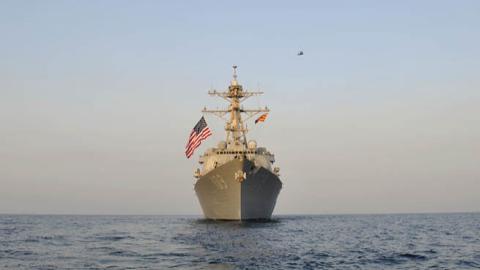Executive Summary
The US fleet is at an important crossroads. Nearly twenty years after the drive for transformation led to costly and problematic programs such as the littoral combat ship (LCS), Gerald R. Ford-class aircraft carrier, and Zumwalt-class destroyer, the Navy is again starting work on new ships in every vessel category. It is essential to make smart decisions on the design of these ships, and of the fleet as a whole, to create a force that affordably supports future defense strategy and avoids mistakes of the past.
The Navy is arguably facing a once-in-a-century combination of challenges and opportunities as it embarks on its new family of ships. Today its leaders, like their predecessors in the years after World War I, are reconsidering the relevance and survivability of the fleet’s premier capital ship. In addition, emerging technologies are enabling new platforms and tactics that could disrupt the design of today’s fleet; rising adversaries are threatening US allies and the international order; and budget constraints prevent the Navy from countering revisionist powers by simply growing the fleet with better versions of today’s ships and aircraft. Today’s Navy, however, unlike its interwar predecessor, sustains a global presence to underpin a network of alliances and protect vital sea lanes and does not have the luxury of bringing the fleet home to retool for the emerging competition.
The Navy will need a new fleet design to affordably address its challenges and exploit its opportunities while maintaining today’s operational tempo. Unfortunately, its current plans fail to deliver on these goals. The force structure reflected in the PB 2020 Shipbuilding Plan and FY 2021 budget, by continuing to emphasize large multimission combatant ships, includes too few ships to distribute the fleet or create sufficient complexity to slow or confuse an enemy’s attacks. Moreover, the fleet’s weighting toward large manned platforms creates unsustainable O&S costs that the Navy is even now struggling to pay.1
The Navy Needs a Theory of Victory
Navy force structure requirements rest on an implicit or explicit concept for how the Navy will deter aggressors or win if deterrence is unsuccessful. The last two decades of Navy assessments assembled requirements from the bottom up, building campaign plans to fight in canonical scenarios and determining the forces needed to succeed using modeling and simulation. These needs, combined with the day-to-day naval presence needed by combatant commanders, resulted in a force structure requirement.2 The bottom-up method of force structure planning, however, tends to rely on attrition-centric tactics that defeat an enemy in detail, rather than implementing operational concepts that prevent the opponent from succeeding.
Bottom-up force planning may not be appropriate for the emerging strategic environment. The home field advantage enjoyed by potential adversaries like China, Russia, North Korea, or Iran has allowed each to establish a robust network of sensors and weapons designed to raise the bar for US intervention in its region. Under the protective umbrella of these systems, these rivals pursue a wide range of military and paramilitary actions below the threshold of violence that may provide a pretext for large-scale US or allied retaliation. As a result, US commanders are forced to accept significant risk with a proportional response or deploy large, well-defended force packages that could be costly to maintain forward. And if confrontation turns to conflict, the sensor and weapons networks of adversaries could rapidly overwhelm the defenses of US and allied naval forces.
Overcoming these threats in the face of technology proliferation and fiscal constraints will require more than simple attrition. The new joint warfighting concept that the Department of Defense (DoD) is pursuing, and the Navy’s concepts for Distributed Maritime Operations (DMOs) and Littoral Operations in a Contested Environment (LOCE), would suggest the Navy’s theory of victory should instead rest on establishing a decision-making advantage over adversaries.3 This approach, drawn from maneuver warfare, would combine defensive operations to foreclose enemy attack options with a diversity of offensive capabilities and complex force presentations to degrade adversary decision-making.4
Employing a decision-centric approach, US naval forces could implement a theory of victory appropriate to the US position as a status quo power that seeks primarily to deter aggression or prevent it from being successful. As described in the chapters that follow, US naval forces would pursue deterrence by deploying in a resilient posture capable of promptly transitioning to wartime combat.
If deterrence fails, using a combination of distribution, defensive capabilities, and complex presentations, the fleet would slow enemy efforts to neutralize or destroy US naval forces in the region. While the opponent attempts to defeat Navy and Marine Corps units in detail, the fleet would exploit its diversity of weapons platforms and operating locations to attack enemy forces in ways that will impose dilemmas and reduce the enemy’s ability to achieve its objectives in time. The focus on specific targets, consistent with the principles of maneuver warfare, is essential, because US forces will likely be at a numerical disadvantage as the “away team” in future conflicts.5
Decision-centric Warfare Requires New Operational Concepts
The Navy’s fleet design should prioritize a new set of characteristics to implement decision-centric warfare in the emerging strategic and fiscal environment:6
* defensive capacity in each platform or force package to defeat a prompt adversary attack and enable US forces to effectively fire their offensive weapons;
* offensive weapons capacity distributed across numerous platforms and able to sustain strike and counter-maritime operations;
* force package diversity at various scales to enable proportional and sustainable responses to aggression;
* force package complexity to counter adversary decision-making, based on the number of different ways a force package can deliver a warfighting effect; and
* affordable procurement and sustainment costs.
Improving the Navy’s performance in these metrics will require new approaches to important naval missions, as described below. A foundational element of these tactics is the distribution of naval forces as described in the concepts for DMOs and LOCE.7
Context-centric Command, Control, and Communications (C3): Today the Navy manages operations at a theater level and attempts to build resilient wide-area communication networks to support this preferred command and control (C2) structure. Despite sizable investments in backup and redundant systems, these networks are likely to be degraded during conflict with a great power competitor.8
Navy and joint service doctrine direct that when communication with superiors is lost, subordinate leaders should use “mission command,” in which junior commanders take the initiative to continue pursuing the senior commander’s intent.9
However, future US naval forces will likely be unable to execute mission command. Distributed operations and the growing number of unmanned systems and small combatants will probably be too complex for junior commanders to manage without a planning staff. Junior naval commanders will need automated planning tools to execute mission command while imposing complexity on adversaries using deception and sensor countermeasures.10 Decision-support tools would enable C2 relationships to be established based on the availability of communications, rather than building networks that support desired C2 structures.
Intelligence, surveillance, reconnaissance, and targeting (ISRT) and counter-ISRT: For US naval forces, the continued proliferation of passive RF, electro-optical/infrared (EO/IR), and acoustic sensors, as well as the expanding number of commercial and military satellite constellations, creates a detection challenge. Naval forces are unlikely to be successful if they attempt to hide at sea. Instead, US naval forces operating inside an enemy’s weapons range should focus on degrading enemy sensors, increasing the number of targets presented to the enemy by deploying RF, IR, and acoustic decoys, and modestly obscuring the signatures of both real and decoy naval units above and below the water. This approach will present an opponent with numerous equally plausible targets. The enemy will either have to attack all the potential targets, using more weapons and potentially escalating beyond what was planned, or wait to analyze US operations and potentially lose the initiative.
To reduce the likelihood of being detected by an opponent’s passive sensors, naval formations will also need to employ more passive and multistatic electromagnetic (EM) sensing. Large active radars like the SPY-1 and SPY-6 should be employed around high-value targets such as airbases ashore or aircraft carriers that will suffer large-scale attacks and are likely to be located using other means. For self-defense, surface and amphibious forces should rely on cueing from passive RF or EO/IR sensors on unmanned airborne aircraft or balloons, vessels, and LEO (low earth orbit) satellites; they should use radars in ways that reduce their likelihood of detection and only for final targeting and engagement.
Air and missile defense (AMD): More distributed formations will dilute adversary attack salvos, reducing the number of weapons each ship or force package may face. The proposed fleet architecture will combine disaggregated operations with air defense tactics that focus on shorter ranges, allowing greater reliance on electronic warfare, directed energy weapons, and smaller surface-to-air interceptors that can be carried in larger numbers. The Navy’s current layered air defense approach, including long-range interceptors like the SM-2 and SM-6, will be employed to protect larger platforms such as amphibious assault ships (LHA/LHD) and aircraft carriers.
Anti-submarine warfare (ASW): Today, submarines and surface combatants contribute to ASW, but they will need to devote more of their effort to strike and air defense in the future fleet. The Navy will therefore need to increase its reliance on unmanned vessels and sensors to conduct ASW sensing, supported by unmanned and manned aircraft to pounce on targets with affordable suppression weapons, rather than large, expensive torpedoes.
Land and maritime strike: The limited reach of today’s carrier-based tactical aircraft and small number of refueling tankers planned by the Navy will constrain carriers’ offensive capacity from ranges where carrier strike group (CSG) defenses can defeat enemy weapons salvos. Although aircraft with standoff missiles can conduct strikes 1,000 nm from a carrier with minimal refueling, these weapons are the same price as their surface-launched counterparts and carry the additional cost of the air wing and carrier escorts. A growing proportion of strike operations will therefore be conducted by surface combatants, complemented by submarines for strike or anti-surface warfare (ASUW) attacks from inside highly contested areas.
Amphibious operations: Today’s fleet is designed to support amphibious assaults from short range, but these operations are too challenging in the face of anti-ship threats from great or regional powers. Instead, marines will increasingly be used to conduct widely distributed missions ashore as part of the EABO concept. For example, even small Marine F-35 detachments with short-range air defenses could compel opponents to shift tactical aircraft to suppression or escort operations; similarly, Marine anti-ship missile launchers could impact an opponent’s maritime freedom of action. The Navy’s amphibious fleet will need some ships designed to support these littoral operations and others for open ocean movement of marines and equipment.
Mining and mine clearance: Mining will be an important component of naval maneuver warfare, as it inherently imposes dilemmas on an enemy. Mine clearing was a rising priority for the Navy during the last decade and is a primary mission for the LCS. Although the LCS mine warfare mission package is delayed by performance shortfalls, its emphasis on unmanned systems reflects the future of offensive and defensive mine warfare. The portability and scaling possible with unmanned systems suggest the Navy should decouple mine warfare from the LCS and deploy these packages on a range of vessels to support minelaying and clearing.
A Closing Window of Opportunity
Navy leaders need to establish force structure requirements and plans that address the US military’s operational challenges by exploiting conceptual and technological opportunities within the Navy’s likely resources. The past two decades of Navy force designs failed to create a larger, more sustainable fleet because of their overly optimistic assumptions regarding budget constraints and technology maturation. Going forward, the Navy will need to emphasize affordability and executability in its plans to gain the confidence of industry, Congress, and allies abroad.
There is still time for the Navy to change course and develop a force better suited than today’s fleet to long-term competitions with great and regional powers. The long-term changes to Navy fleet architecture proposed above would be significant. However, by acting now, Navy leaders could begin an evolutionary approach that brings on new platforms after reasonable concept and design development, while continuing to produce proven ships to sustain the industrial base and recapitalize some of today’s multimission vessels as they retire.
But the window for the Navy to start this evolution is closing. Adversaries may intensify their efforts against America’s allies if they perceive US leaders are focused on domestic concerns and unwilling to sustain operations abroad. Fiscal constraints will also begin to foreclose options for the Navy to adopt a new fleet design. As shown above, O&S costs for the fleet grow faster than inflation even with the proposed Hudson fleet architecture. Every year that the Navy delays rebalancing the force to smaller, less-sophisticated, and less-manpower-intensive platforms means higher sustainment costs that will crowd out research and development or procurement of next-generation ships, aircraft, and mission systems.
Today’s Navy leaders, like their predecessors between the world wars, have an opportunity to establish an enduring advantage against US competitors. Without significant change, however, the fleet could enter a spiral of rising costs, shrinking numbers, and technological irrelevance. The Navy and Congress should act now to ensure this does not happen.



















